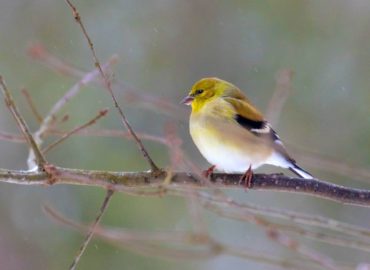
Pine siskins, American goldfinches and common redpolls are cousins, members of the large finch family. During the winter months, they frequently flock together in the search for food. Flocks of pine siskins can grow into the hundreds at this time. You have to look at them carefully if you want to find a species other than a siskin.
In the fall, American goldfinches exchange their brilliant summer coloring for drab winter plumage and lose their black caps. They blend into the siskin flocks and often go unnoticed. If what looks like a siskin doesn’t have any streaks on its breast, expect a goldfinch.
Siskins are streaked all over and have small, pointy bills and a bit of yellow in their wings and rump. Redpolls have little streaking and the male’s breast is a pale-rosy pink. As the name implies, both sexes have a bright-red cap on their forehead. The small, black chin on both the male and the female is also a distinctive marking.
All three of these finches are attracted to feeders containing sunflower seeds, shelled and unshelled. Their favorite food is thistle seed. When you offer thistle, it is important to use a feeder designed just for very small seeds. The holes need to be much smaller than regular seed feeders. Otherwise the seed will spill on the ground.
Goldfinches and pine siskins are regular winter visitors in the Pacific Northwest but the redpolls are uncommon to rare. These are northern birds that nest in the Aleutian Islands and across Arctic Alaska and Canada. They are resident in the northern climes and their movement southward during the winter only reaches as far south as Washington’s northeast counties and into Idaho, Montana and Wyoming.
Common redpolls are sometimes referred to as “Valentine’s Day birds.” In those northern states where the winters are more typical, local birders have noted that common redpoll often show up around that time. This year, the first local sighting of common redpolls was from Bainbridge Island. Other reports were of birds seen near Hansville at Point-No-Point.
Numerous reports from King County, Mason County and several other areas have noted that good numbers of redpolls are being seen. A drop in food supply, along with colder-than-normal weather, may have forced large numbers of migrant redpolls into Western Washington this winter.









Comments